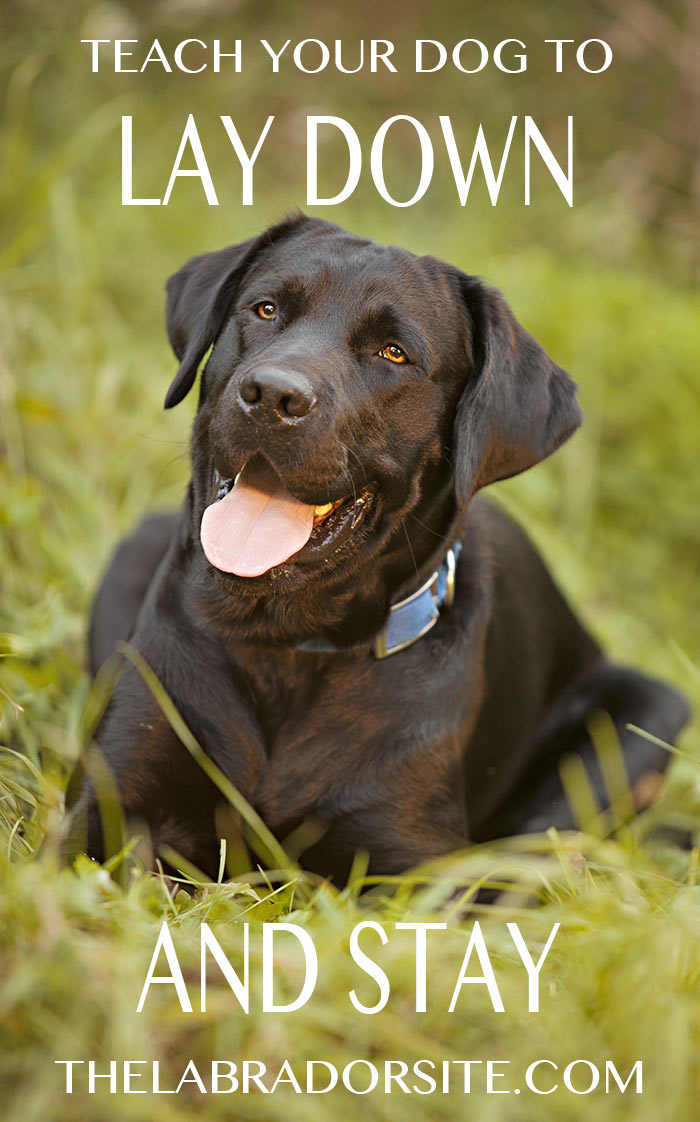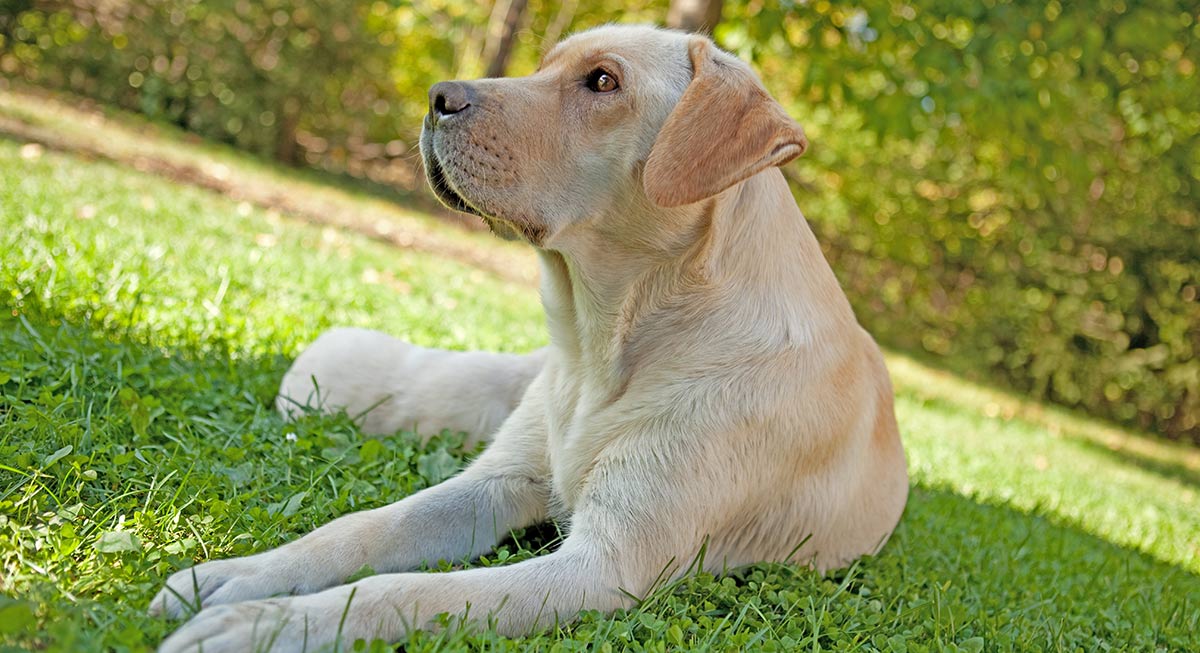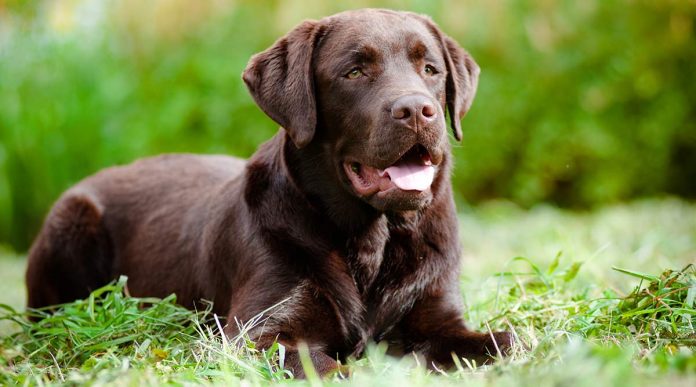If you would like your dog to drop quietly into a down position at your signal, you’ve come to the right place.
Today I’ll show you how to teach your dog to lay down. And to stay there until you decide he can get up again!
CONTENTS
Physical manipulation is not needed, so you won’t need to wrestle your dog to the floor, tug down on his leash, or get cross with him.
The modern methods you will find here are both fun and effective.
Why bother to teach your Lab to lay down?
Many people find down a bit harder to teach than sit. But it’s well worth persevering with.
Down is a very useful command.
A dog can relax fully in the down position and therefore it is the ideal position for teaching a long ‘stay’.
Being able to get your dog to lay down at a quiet word or a hand signal gives you a great deal of control over your dog. And enables you to take him everywhere with you. Even in the most polite company.
Benefits of teaching down
Imagine being able to take your dog into any public building or park, drop into a down position, and stay there quietly while you talk to a friend.
Or to take him to a friend or relative’s home
And have him lay down quietly while you share a coffee and a chat.
These things make life with a dog so much more pleasant and will bring you a little glow of pride.
They are also within your grasp.
Teaching a dog the down position – different methods
Modern dog training methods are gentle, kind, and effective.
There are several different ways to get your Labrador to lie down. And most of them are suitable for your dog.
The only one I don’t recommend is the first on this list
- Force
- Capturing
- Luring
- Shaping
Let’s look at each one in turn
Old fashioned trainers sometimes forced a dog into the down position by pushing him, pulling on his front paws
Or by pulling him down to the floor.
If you are old enough, you probably remember seeing someone attach a lead to a dog’s collar, and step on it, while pulling up on the other end. So that as the owner’s hands come up, the dog’s head is forced to go down
This was a messy, difficult, protracted and sometimes upsetting process. Usually accompanied by the handler repeatedly saying ‘down’
It often took a long time to get the dog to understand the whole process because a dog’s natural response to being pushed and pulled, is to resist. And because he naturally thought that the word ‘down’ meant ‘let’s wrestle’.
Your down signal
Before you start training, decide what your dog signal or ‘cue’ is going to be.
This cue needs to be a clear ‘signal’ – the word ‘down’ is fine – though you’ll find a lot of people say ‘down’ to a dog when they mean ‘don’t jump up and put your paws on me’.
So if your dog is allowed to put his paws on people, you might want to choose a different word – ‘drop’ for example.
This is because we don’t want the word ‘down’ to be associated with anything other than the ‘down’ position.
You can also use a hand signal. It’s usually simplest to add this afterwards, once the dog understands the verbal down cue.
In both cases, don’t give your Labrador any commands whilst you are establishing the new behavior.
In modern dog training we add the signal or cue, once the dog is repeatedly adopting the position. This helps him understand the cue word much more quickly because it it always associated with the right behavior.
The first step then, is to get the dog repeatedly and reliably assuming the down position, before adding the command.
Teach your dog to lay down method 1 – capturing
This method involves waiting for the dog to lie down naturally, and giving him a great reward when he does so.
This is where some patience and a good book or a newspaper comes in handy.
Because you are going to wait for your Labrador to lie down of his own accord and when he does you will say YES! In an upbeat, distinctive, and happy way.
Immediately you say YES you must throw the dog a tiny treat.
He’ll probably get up when you say YES and he’ll certainly get up when you throw the treat, but that’s okay. All we are doing at the moment is creating a ‘snapshot’ in time that tells the dog that you liked it when he lay down.

Once you have ‘captured’ a down like this three or four times, the dog will start to realise that he is triggering the rewards you are giving him and try to figure out what it is that he is doing that is making the rewards happen.
This is where your YES starts to come into its own.
The YES tells the dog exactly which of the things he did, that you liked better than all the others. It’s what we call an ‘event marker’ You can use a clicker instead of the word YES if you prefer.
Your dog may stand in front of you wagging his tail for a while, in the hopes of getting another treat.
Just wait him out.
Then as soon as he gets bored and slumps to the floor, YES and another reward arrives.
If your dog has been trained using this method for a different skill, he will ‘catch on’ quite quickly. Dogs that are not used to working with a marker will take a bit longer, but once they ‘get it’ you will be away!
If capturing sounds boring to you, you might prefer to try luring the down
Teaching your dog to lay down method 2 – luring
To lure the dog into a ‘down’ you will need to have a nice treat tucked in your hand.
Once your lab is sitting, you can hold your hand containing the treat in front of his nose and lower it gradually to the floor.
From a standing position, this may result in a dog with his butt in the air, so use the fold back down technique from the stand.
A ‘fold back’ down
You can get a really nice ‘fold back’ down by holding the treat in front of the dogs nose and pushing your hand with the treat in it at an angle towards the floor – aiming at a spot between the dog’s rear paws
Most dogs will lean back with all four legs folding together when you do this.
Release the treat as soon as the dog’s belly meets the floor.
Losing the lure
With luring, it’s important to ‘lose’ the lure very quickly so that you don’t become dependent on it.
Once your dog has gone into a down a few times (three or four) with the lure, then you need to repeat the process with an empty hand.
Have a treat ready in your other hand or close by
Use exactly the same hand position as if it still had a treat in it, show the dog your empty palm first then ‘fake lure’ with your hand, and treat him immediately.
Lots of practice will soon have the dog dropping into a ‘down’ when you put your closed hand in front of his nose.
Teaching your dog to lay down method 3 – shaping
Shaping is a lot of fun, and if you are into clicker training, you will probably prefer this method.

Follow this marker sound with a nice edible reward.
Throw the treat away from the dog so he has to change position to get it.
That enables him to then offer another head drop or other downward movement in order to get another reward.
Soon the dog will be lowering his head or upper body every time you get out your treats and clicker.
That is great. Now all you need to do is move the goalposts a little with every training session.
Stop marking the small movements and wait for him to go even lower.
Finish up by insisting on a full ‘down’ with elbows and belly firmly on the ground, before marking and rewarding his position.
Once you have a dog that will drop quickly into the down position when he sees you in training mode, you are ready to add a cue
Adding your signal – giving the down command
A dog can only obey a command he understands. Fortunately, this part is pretty straightforward.
You are going to give the down command just a fraction before your Labrador goes into the down position.
If you are luring, say ‘down’ just before moving your hand towards the dog’s nose.
If you are shaping, get your first ‘down’, throw the treat away from the dog, and say down as soon as he starts to offer another down. Repeat several times.
Switching cues
Switching cues is an important part of making sure your dog understands your signal.
Next session it’s time to give the dog a different cue. Sit is usually ideal.
To begin with, you will find he probably lies down when you say sit. This is because he doesn’t yet truly understand the down cue.
Lure him up into the sit position with a treat over his nose and treat him. The throw a treat away and ask him to sit as he comes back towards you. Repeat until he starts sitting on cue and stops lying down.
Now ask for a down!
If he sits, wait for a moment to see if he lies down. Treat if he does, lure him into a down if he doesn’t. Repeat with ‘down’ until he lies down every time you ask him to then switch back to sit again.
Eventually, you will be able to alternate sit or down, or give two sits and one down or vice versa, and the dog will accurately respond to the cue with the correct response.
This may take two or three sessions. Once you have achieved this, you can be sure that your dog understands what the down cue means.
Your obedient dog
Now try to take your dog by surprise with a ‘down’ command in different locations around the house.
If he obeys, mark and reward. Take him by surprise again later.
If he doesn’t obey, just practice a few more times by playing the regular game and adding the down command as a part of that game.
Then try a surprise ‘down’ again later. He will soon get it, and you will have a dog that obeys the ‘down’ command anywhere in your home.
At this stage always have a reward ready for him. And don’t try to do this outdoors until you have read the rest of the instructions
Teaching your dog to stay
Most every time when you tell a dog to lie down, you do not want him to get straight up again. So let’s add some duration to this ‘down’ command.
Before we do that, I’ll quickly talk about the ‘stay’ command.

Surely, when you tell a dog to lay down, you mean ‘lay down and stay til I say you can get up’?
That is what ’down’ means. It is a long duration behavior, and one that we use practically, when we want the dog to stay in one place for a significant length of time.
Teach your dog a release cue
A release cue is a great tool in dog training. It says, we’re done, you’re free to go. No more training games for the time being.
Ideally you should choose a release cue that isn’t frequently heard in conversation. I use ‘okay’ some people use ‘free’ or ‘off you go’. These are probably better choices, especially if the whole family will be giving commands to your dog.
If you are using a marker such as YES, or a click from a clicker, then that is your release cue.
You don’t need to add another, though at this point you can swap the click or word yes for a permanent release cue if you want to.
Building duration to your dog’s down
Duration is the first component of the stay. Do this indoors.
To begin adding duration to your dog’s ‘down’, simply wait a second or two with the dog in the down position before releasing him.
If he gets up again, then he gets no reward. Build up duration gradually. Two seconds then three, then five, then ten. And so on.
Mix short and slightly longer stays together in a sandwich.
Don’t expect too much from puppies. A thirty second ‘down’ by five to six months old is reasonable.
A one year old dog should be able to lie down for half an hour whilst you eat a meal or chat to friends. But build up slowly.
Leaving the dog laying down
Distance is the second component of the stay. You should begin this indoors too.
Once you have got a thirty second stay, you can start to introduce a little distance between you and your dog.
Take a step away from the dog and return. Mark and reward if he maintains the down.
Make the exercise easier if he does not.
For example, to begin with, you can lift one leg and put it down again rather than actually moving away.
Gradually increase the distance that you move away from your dog over several training sessions.
You should be able to walk several steps away from the dog and sit in a chair on the other side of the room for a few seconds at this point
Return to the dog
In the early stages of down (or sit) stay training, you must always return to your dog before marking and rewarding the ‘down’.
If you fail to do this and start calling your dog to you from the ‘down’, he will quickly anticipate your behaviour and may be tempted to ‘break’ his stay.
You will then need to go back to the beginning again and build up slowly.
Proofing your down command against distractions
This is the part where we teach the dog to stay lying down, even when other things are going on around him. We are still indoors at this point.
Gradually introduce more distractions, family members walking around the dog, even stepping over the dog (carefully).
Reduce both duration and distance when you do this. Build them back up one the dog is solidly reliable with the distraction you have introduced
Break it down into easy stages and back up a stage if he starts to fail. Teach your dog to lay down whilst you go in and out of doors, and even out of sight for a moment.
Eventually you should be able to have him lie down whilst you answer the door or let visitors in.
Rewarding your dog for lying down
Use rewards effectively. This means BIG rewards each time you make things more difficult.
Fade rewards to a minimum once he has the hang of it (never discontinue rewards completely) then BIG rewards when you make things more difficult again.
Advanced down command training
Once you have introduced distractions to the ‘down’ at home, you can take your lovely ‘down stay’ out into the wide world.
But be careful to practice in very controlled conditions first.
For example, get a friend to be your ‘fake’ distraction and walk past your dog quietly with her dog on a lead.
If you take your dog to the local recreation ground whilst your son plays football, teach your dog to lie down as far away from the pitch as you can.
When he is successful repeatedly, you can shorten the distances until he can lie quietly on the touchline whilst you watch the match.
Don’t throw him in at the deep end.
Teach him to lie down for very short periods in new places and increase the duration of the ‘down’ and the power of distractions gradually.
Summary
Teach your dog to lay down and stay by establishing the down position with rewards and increasing distance, duration and distractions in easy stages
Use capturing, luring or shaping to get the initial down position. I recommend luring as it is very quick. But shaping is a lot of fun too.
A marker, such as a clicker or the word YES is a useful aid to training, and you’ll find twice daily sessions five or six days a week bring the fastest results.
Have fun training the down, and post up any tips or questions you have in the comments box below!
More information on Labradors
If you’d like all of our best Labrador information together in one place, then get your copy of The Labrador Handbook today.

The Labrador Handbook looks at all aspects owning a Labrador, through daily care, to health and training at each stage of their life.
The Labrador Handbook is available worldwide.
You can buy The Labrador Handbook from Amazon by following this link(paid link). If you do, The Labrador Site will receive a small commission which is greatly appreciated and won’t affect the cost to you!
Teach Your Dog To Lay Down was originally published in 2012 and has been extensively revised and updated for 2016
The Labrador Site Founder
Pippa Mattinson is the best selling author of The Happy Puppy Handbook, the Labrador Handbook, Choosing The Perfect Puppy, and Total Recall.
She is also the founder of the Gundog Trust and the Dogsnet Online Training Program
Pippa's online training courses were launched in 2019 and you can find the latest course dates on the Dogsnet website


















Hi Pippa,
Am I allowed to use this article as reference to support my assignment?
kind regards
akbar
Perhaps it is me, but I assume you need a way to ‘release’ the from”down” or “sit”? Am I off base, if not, how is that done?
My 6 months old lab does lie down at home – but outside, when the ground is wet, he refuses (yawning, looking around) even if I have the nicest treat for him.. How do I get him to lie down anyway?? Thank you!
Wow! Talk about timing, I came to this very article yesterday to ask why my 4 month old lab wasn’t getting “lay down” after he had picked up sit and even shake hands so well. I had been trying for weeks to get him to lay down! I had been gently guiding his front legs to the ground whilst saying “lay down” and then tried luring him but all he would do is stand up and try to get the treat. I had my question all typed out then decided to give it a bit more time before I asked for help.
Then yesterday when I got home, I had a brief training session with him. After guiding him down gently twice, I then lured him, and instead of standing up, he laid down! Twice! I was so happy with him getting it after just two aided attempts. We played his favourite game as a reward.
Maybe two times out of five now he will lay down when I lure him. He still stands up to take the treat which is natural given he’s only literally just picked up how to lay down, but I am so pleased with his progress!
My seven-month-old lab learned “down” very young using the luring method. He has never liked it and will only do it if I have a treat and lure him from a sit position to a down position. I feel we should be beyond this by now and he should do it on command without being lured. Is my assumption fair? He is a sweet, head strong male who also struggles with recall.
Have a look at this article: Learning to lure
My Lab Pasco does not like to learn to lie down,,, try many ways…oef.
Hi Robert, he will like it if you make it rewarding. Use the luring method. Check out this article too Rachael learns to lie down